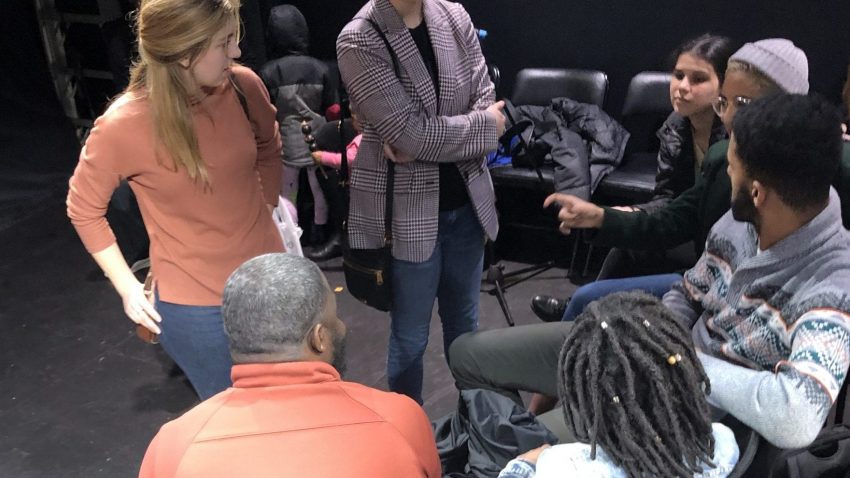I found myself leaving Anacostia Arts Center feeling incredibly moved and empowered. After the last few days of performances focusing on heavy topics that led to even heavier discussions, I felt a bit drained. I had no idea what to expect beforehand, but the performance we saw by District Community Playback rejuvenated me in a way I didn’t quite know I needed.
Anacostia Arts Center opened in 2013 with the mission of “…creating a home for small businesses, artists, arts, and cultural organizations to fulfill our commitment to the revitalization and sustainable economic development of Historic Anacostia.” Arch Development Corporation purchased the property in 1999. Between 1999 and 2011, Arch acquired funding and transformed the space into a small business incubator. With input from Anacostia residents, it was decided the community did not need another social service agency, so instead they built an arts center “with an aim at employing the arts and the creative economy.” The arts center houses space for five galleries/boutiques, a short term exhibition gallery, a cafe, a lounge area, and a 1,000 square feet blackbox theatre where we saw the performance by District Community Playback. Just the layout of the venue highlights black owned businesses and excellence. Before the show, one could walk across the hall to Mahogany Books and support black writers before they are about to engage with the community in the performance.
District Community Playback “is a professional theatre company committed to shedding light on the barriers that divide us, so that we can move from strangers to neighbors.” John Johnson, a member of District Community Playback and a native Washingtonian, has the goal that his work “creates meaningful transformative conversation after the audience experiences this unique form of theater called playback.” Playback theater is an interactive form of theater where audience members tell stories from their lives and watch them enacted. The show we saw definitely fulfilled Johnson’s goal and District Community’s mission. Today’s performance was the most democratic performance we have seen on this trip. This show defined American identity by sharing the stories of its audience members. Of course, with democracy comes the messiness of it all, due to the variety of stories shared. In our post show discussion, Johnson touched on how federal institutions and schools are hesitant about partnering with them because they literally cannot be censored. This is a prime example of modeling democracy with performance arts. Playback shows how theater can be funny, impactful, and thought provoking all in the same performance.

Democracy and the Arts students engaging in conversation with other Audience members sharing “memorable D.C. stories”
Each performance of playback can and will have completely different outcomes. Our show today had humorous and heartwarming stories such as a classmate of mine spilling coffee on herself in Amy Klobuchar’s office, a man and his girlfriend getting on the VIP list for a Rancid concert all because of some vegetable juice, and a young girl going to a go-go concert despite her age. These stories were juxtaposed with stories such as a young man’s experience after his father’s death during the same time of the D.C. Sniper and a story of a man’s experience at the Million Man March in 1995 and the power and love he felt at that time.
Even the two more lighthearted stories about music called out the legacy of segregation in the music scene in D.C. Go-go and Punk. The Black Hole and Black Cat. The story about the punk band Rancid ended with a concert at the Black Cat, while the story about go-go ended with a concert at the Black Hole. The Black Cat was later described as the equivalent of the Black Hole for white people. This is the power of the performance and conversations it sparked. These two lighthearted stories about audience members youth highlights an issue in D.C. that goes far beyond the music scene.
This performance showed me the humanness of theater. I found myself connecting to an extremely diverse audience and engaging in conversations that I otherwise never would have. I would be interested in taking playback theater back to St. Olaf. While I’m not an actor or involved with theater at all, I’m excited to suggest this idea to friends and professors who are. Our campus could benefit from the impacts of playback theater to help foster a more empathetic and connected student body.
“About the Center.” Anacostia Arts Center, anacostiaartscenter.com/about/.
“Mahogany Books.” Mahogany Books, www.mahoganybooks.com/.
“Million Man March.” Encyclopædia Britannica, Encyclopædia Britannica, Inc., 9 Oct. 2019, www.britannica.com/event/Million-Man-March.
“Our People.” Anacostia Playhouse, www.anacostiaplayhouse.com/playhouse-staff/.
“What Is Playback Theatre?” International Playback Theatre Network, www.iptn.info/?a=group&id=what_is_playback_theatre.
“Where Storytelling and Art Meet Community.” Verbal Gymnastics, verbalgymnastics.com/.
